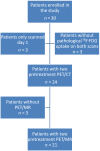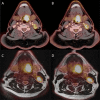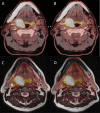Reproducibility of (18)F-FDG PET uptake measurements in head and neck squamous cell carcinoma on both PET/CT and PET/MR
- PMID: 25634069
- PMCID: PMC4651251
- DOI: 10.1259/bjr.20140655
Reproducibility of (18)F-FDG PET uptake measurements in head and neck squamous cell carcinoma on both PET/CT and PET/MR
Abstract
Objective: To investigate reproducibility of fluorine-18 fludeoxyglucose ((18)F-FDG) uptake on (18)F-FDG positron emission tomography (PET)/CT and (18)F-FDG PET/MR scans in patients with head and neck squamous cell carcinoma (HNSCC).
Methods: 30 patients with HNSCC were included in this prospective study. The patients were scanned twice before radiotherapy treatment with both PET/CT and PET/MR. Patients were scanned on the same scanners, 3 days apart and according to the same protocol. Metabolic tumour activity was measured by the maximum and peak standardized uptake value (SUVmax and SUVpeak, respectively), and total lesion glycolysis from the metabolic tumour volume defined from ≥50% SUVmax. Bland-Altman analysis with limits of agreement, coefficient of variation (CV) from the two modalities were performed in order to test the reproducibility. Furthermore, CVs from SUVmax and SUVpeak were compared. The area under the curve from cumulative SUV-volume histograms were measured and tested for reproducibility of the distribution of (18)F-FDG uptake.
Results: 24 patients had two pre-treatment PET/CT scans and 21 patients had two pre-treatment PET/MR scans available for further analyses. Mean difference for SUVmax, peak and mean was approximately 4% for PET/CT and 3% for PET/MR, with 95% limits of agreement less than ±20%. CV was small (5-7%) for both modalities. There was no significant difference in CVs between PET/CT and PET/MR (p = 0.31). SUVmax was not more reproducible than SUVpeak (p = 0.09).
Conclusion: (18)F-FDG uptake in PET/CT and PET/MR is highly reproducible and we found no difference in reproducibility between PET/CT and PET/MR.
Advances in knowledge: This is the first report to test reproducibility of PET/CT and PET/MR.
Figures





References
Publication types
MeSH terms
Substances
LinkOut - more resources
Full Text Sources
Other Literature Sources
Medical

